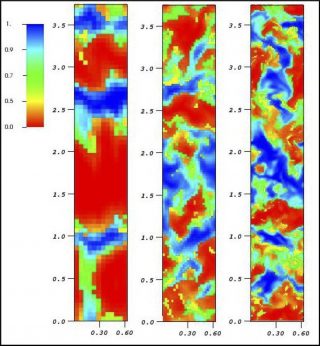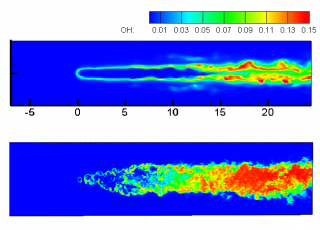The goal of this project is to deliver high-fidelity multiphysics, multiscale simulations and improve the confidence in prediction through verification, validation and uncertainty quantification of turbulent mixing due to interfacial instabilities.
Computational Fluid Dynamics
Understand the interfacial instability mechanism on the important science and engineering problems.
In our daily lives we all have experienced turbulent motion, for example when we pour milk into our tea or coffee. Understanding turbulence is a challenging scientific endeavor because it requires capturing the chaotic and capricious eddies of flows as well as interpreting the disturbance and the development mechanism. Complex systems of turbulence occur in a wide range of engineering applications including gas turbines and combustors for ramjets and scramjets, rocket motors accelerating a tank and electrocardia. These examples display complex geometries and fluid interactions that need to be investigated carefully. Computational modeling and efficient and accurate numerical algorithms are key to predicting the behavior of turbulence.
Uncertainty Quantification
Quantify the uncertainties in the mathematical model inputs and the model itself.
One needs to characterize all uncertainties in the model inputs and parameters to quantify their effects on the simulation outcome to improve the performance of the numerical studies. Therefore, uncertainties and errors in the model inputs and the model itself cannot be ignored and need to be quantified in experiments and simulations to achieve acceptable performance. This project involves the development and use of advanced UQ methods for global sensitivity analysis and surrogate construction. Sensitivity analysis based on polynomial chaos expansion (PCE) helps to quantify how strongly uncertainty in output depends on uncertainty in the input data. The goal is to build a PCE for our computational model and perform sensitivity analysis with respect to input parameters. A method that depends on the complete probability distribution of input parameters is used to build the surrogate function which is the linear combination of PC coefficients times the multivariate polynomials. The multivariate polynomials are defined as products of univariate polynomials, and the polynomial chaos coefficients can be computed using projection through quadrature integration. Once these coefficients are computed, the variance-based decomposition can be extracted.
High Performance Computing
New parallelization strategies for the modern hardware structures.
To meet our objectives and goals, highly intensive computations are required. Many scientific application codes in computational fluid dynamics require an adaptation to take advantage of modern high-performance computing (HPC) systems. An assessment of the quality and usefulness of a numerical method has to take into account the accuracy, robustness as well as the efficiency factor. It is very important to develop a scheme that takes a reasonable computational time for the simulation of complex flow problems. The focus will be on optimizing and improving the computational performance of the numerical simulations for the compressible turbulent mixing on HPC. The effect of the programming models on time to solution will be investigated through i) the hybrid programming model and ii) the Graphical Processor Unit (GPU) accelerator. The hybrid programming model which is a combination of parallel programming models becomes a dominant approach. The most preferable hybrid model is the one that involves Message Passing Interface (MPI) such as MPI + Pthreads, MPI + OpenMP, MPI + MPI-3 shared memory programming and others with accelerator support. Within all choices, we choose the hybrid programming model which is based on MPI + OpenMP. The top HPC systems on TOP500 list support the GPU-accelerator programming. Directive based programming models for GPU accelerated architectures, OpenACC and OpenMP, will be used to first develop the GPU based accelerator code with the focus on optimizing our application code.
Left: Heavy Fluid Concentration in the simulation of Rayleigh-Taylor instability
Right: Cross-Sectional OH Mass Fraction in the simulation of turbulent combustion with the engine of a scramjet (Mach 7 experimental craft)


Recent Comments